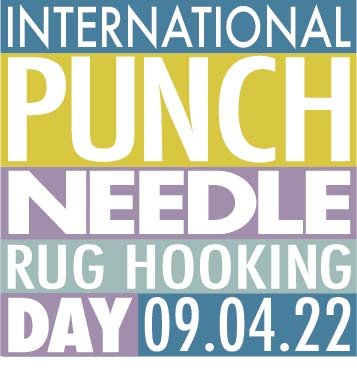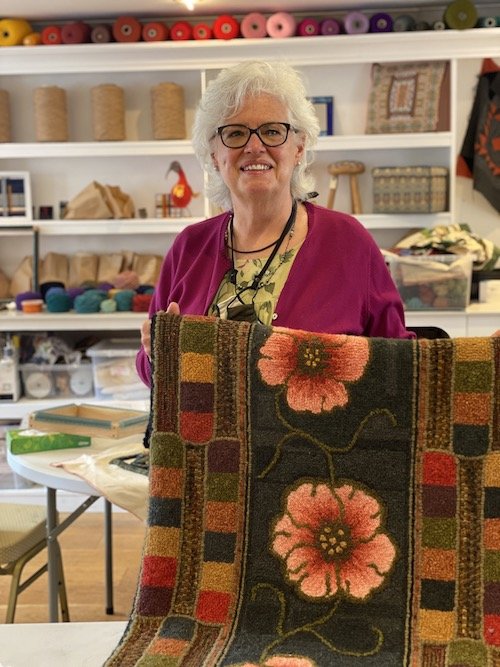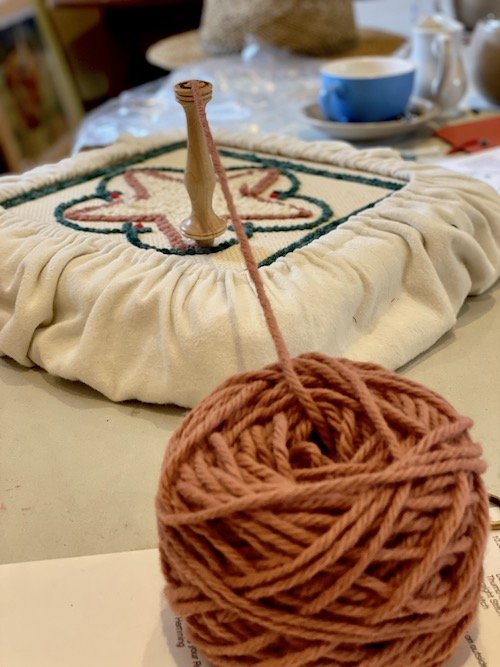Ask the punch needle tutor…
We are delighted to be hosting a Punch Needle Open Day at Stiwdio 3
10am to 3pm Saturday 9th April 2022
Open to anyone and everyone, whether you have some experience or no experience. Join tutor Cynthia Popnoe-Hoad to celebrate and learn about the versatile craft of punch needle rug hooking - the global craft that has gone viral. There will be stations set up for you to have a hands on taster session using the Oxford Punch Needle and Cynthia will be on hand to answer all your questions. Cynthia answers our questions and shows some of her favourite pieces in the interview below.
Interview with top Punch Needle tutor Cynthia Popnoe-Hoad
What is Punch Needle Rug Hooking?
Using a specially designed hollow metal needle, in which you thread through yarn or fabric strips and then manually punch or push the needle through a woven backing fabric to make a loop on the underside of the fabric. As you punch, a running loop stitch is formed. Traditional rug hooking works from the front and pulls loops up, while punch needle works from the back punching loops down.
How does the yarn not fall out of the fabric?
I always like to say it is “magic” and it does a feel a little magical! Actually it has more to do with the warp and the weft! When you push the needle through the backing fabric, you are not making a hole in the fabric but pushing the needle in between the warp and weft of the woven fabric. Each time you push the needle with the yarn through, you make a loop and the more times you punch, the multiple loops you are making create tension or density, thus holding the yarn in place.
Tell us about your Punch Needle Journey
My punch needle journey began 8 years ago, during a trip to Maine, USA where I discovered traditional rug hooking and on my return to the UK I discovered a course being offered in Nottingham using a punch needle rather than a hook. What really “hooked” me was how easy this craft was to learn, how quickly the projects worked up, and how calming it was.
How long has punch needle been around?
Punch needle rug hooking began in the late 1800s. The earliest punch needle we know about was patented in 1881 by G. W. Griffin in New Hampshire, USA, called “The Griffin.” It was considered a great time and labour saving device as it made rug hooking faster. There have been over 100 brands of punch needles that have come onto the market since that time.
The Oxford Punch Needle was designed in 1995, by Amy Oxford, a well known rug hooker from Vermont, USA. Because of the design and functionality, the loops created by the Oxford Punch Needle are more consistent and even than those made using a traditional rug hook. It was also designed to be ergonomically friendly which means it is easier on your hands.
What is it that makes punch needle so absorbing?
It is the same feeling I have when I get lost in a good book and can’t put it down. I am drawn by an idea in my head and the whole process begins - designing the rug, choosing the colours, dyeing the yarn and then punching. I am not a quick puncher and this goes along with my personality as I am a thinker and it takes me a little more time than some in the beginning but once I get punching, I’m immersed and become very focused and absorbed. I love to to watch it grow and find it so rewarding. Although I have a good eye for detail and colour, I have no formal training in art or design so I continue to be amazed at what I am able to create.
How does punch needle support mental wellbeing?
As we create a space for ourselves to punch, we also create a space for ourselves to become aware of the present moment, the colours and textures, the punch needle in our hands, the rhythm of the punch needle going in and out of the fabric.
Through the craft of punch needle we learn how to be in the moment with what we are doing, and we begin to experience things in a new way that perhaps we had been taking for granted.
What do you love about teaching punch needle rug hooking?
I love sharing my skills with others as it gives me so much pleasure to see the excitement in their eyes when their confidence grows as they punch their first project. My belief is that anyone can learn to punch. When students increase their knowledge about punch needle, and understand there is a right and wrong way to punch, their punch needle journey is so much smoother and enjoyable.
Through teaching, I want others to feel confident and competent in their punch needle skills but I also want them to reap the other benefits of punching such as increased confidence, improved mood, a sense of satisfaction and reward from what they have created, new friendships, and improved mental wellbeing.
How you hand dye your yarns?
I have several methods of dyeing wool which I have learned from women in Canada. My favourite is using the 3 primary colours to achieve any colour you want on the colour wheel. Depending on whether I am wanting a solid colour, spot dyed, or mottled will determine whether I use the microwave, oven or dye pot. Dyeing wool is good therapy and the colours are like eye candy, I cannot get enough!
Do you have a piece you are particularly proud or fond of?
There are two pieces I am particularly proud of: 1) my teaching certification rug which I call “Cynthia’s Padulas” (26” x 50”) and my Pandemic Carpet Bag (18” x 12”) ("Padula" is a term coined by the famous rug hooker Pearl McGown to describe a flower that doesn't look like any exact species of flower.). I like larger projects that push me out of my comfort zone and when complete give me such a sense of accomplishment.











